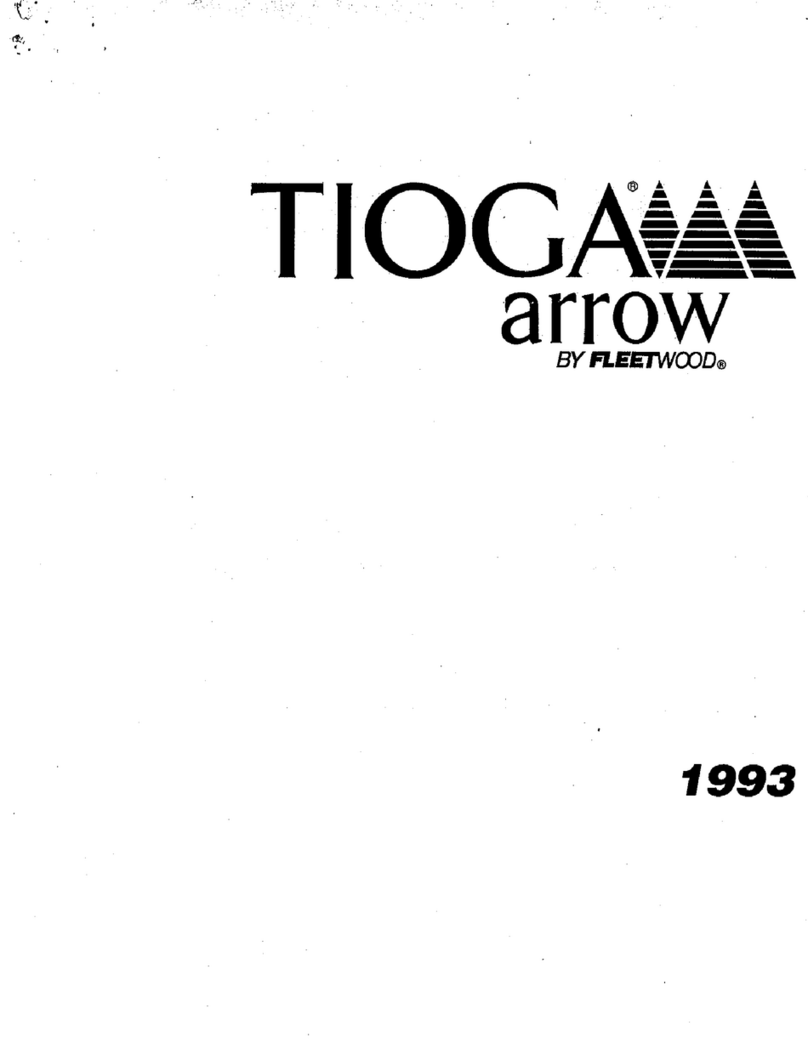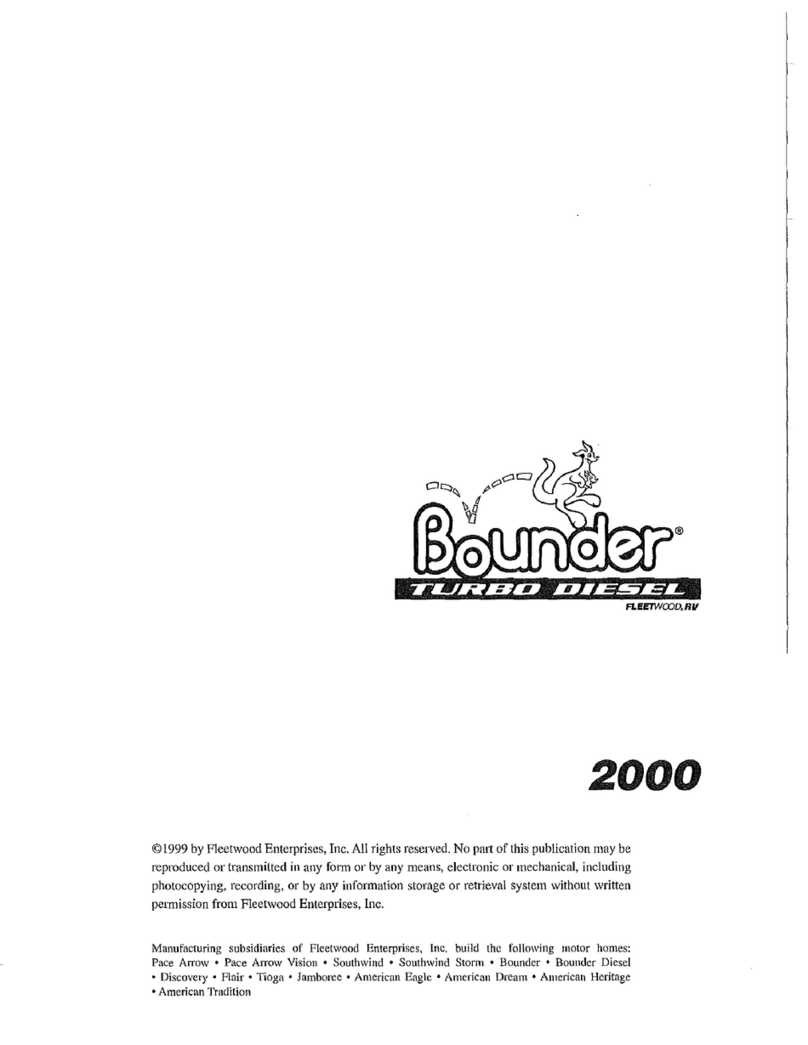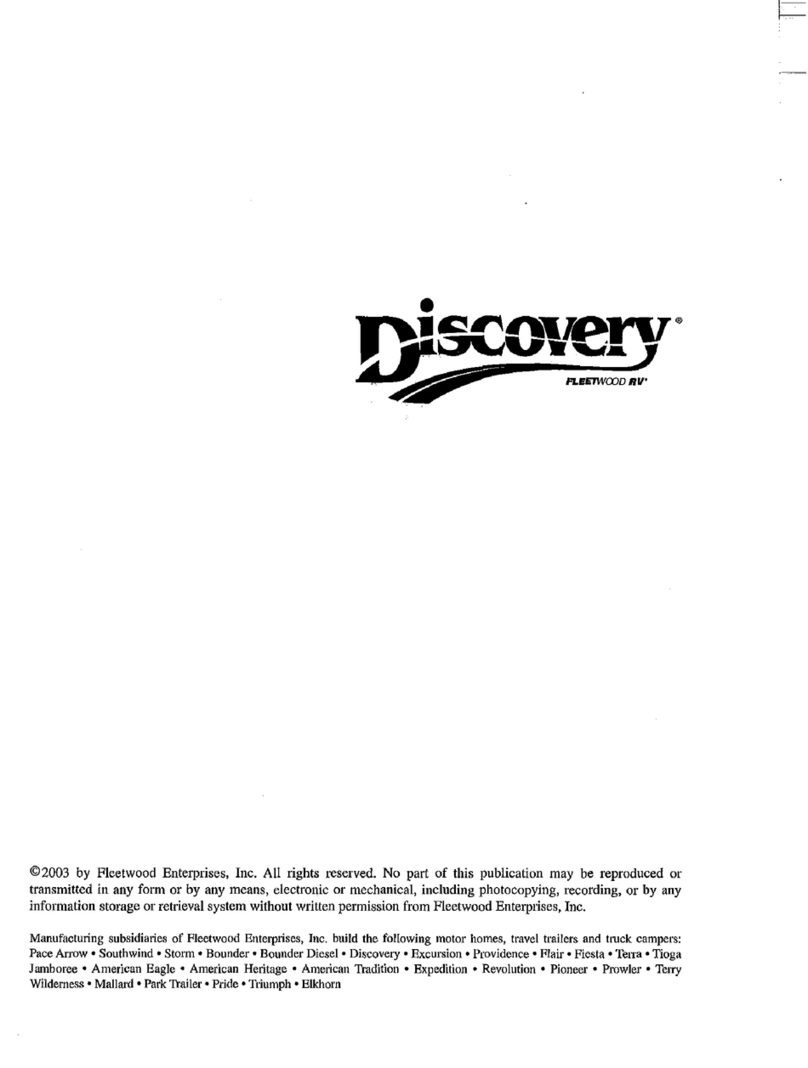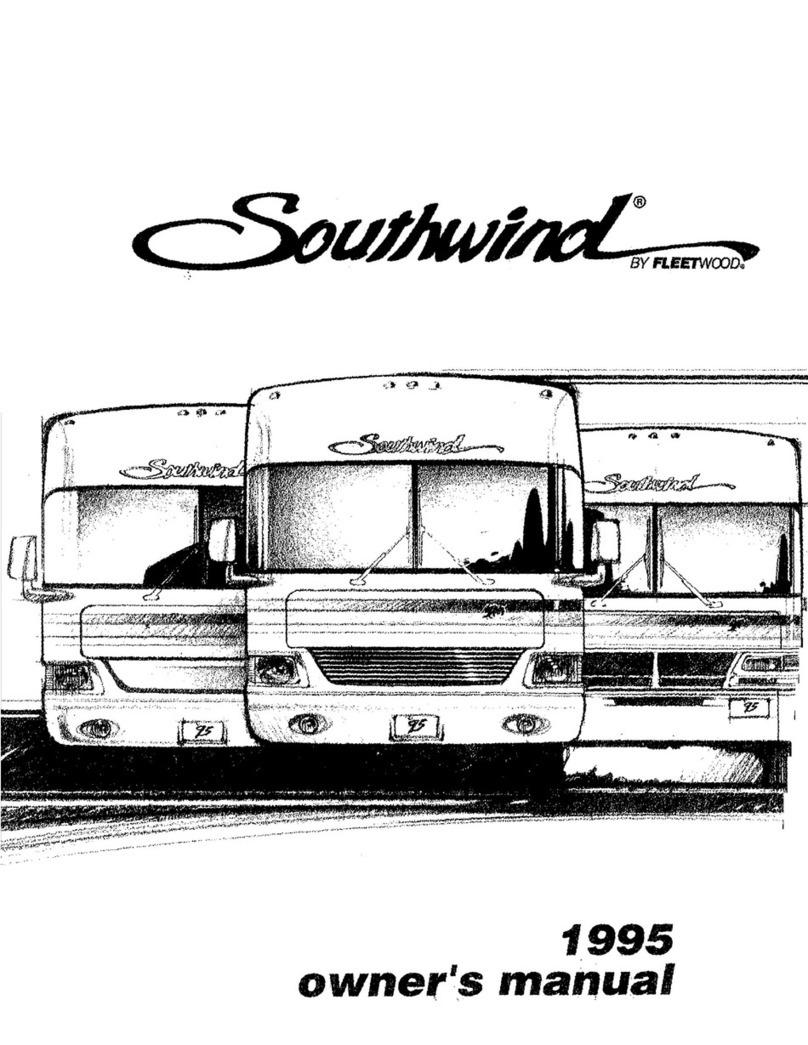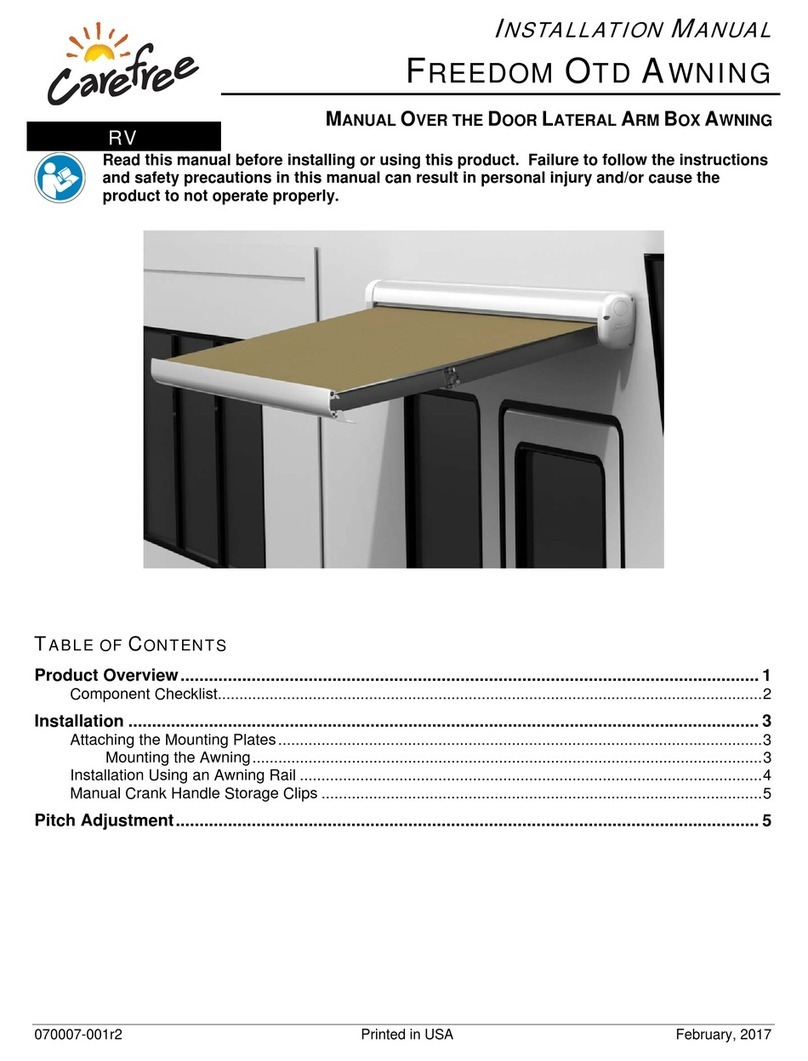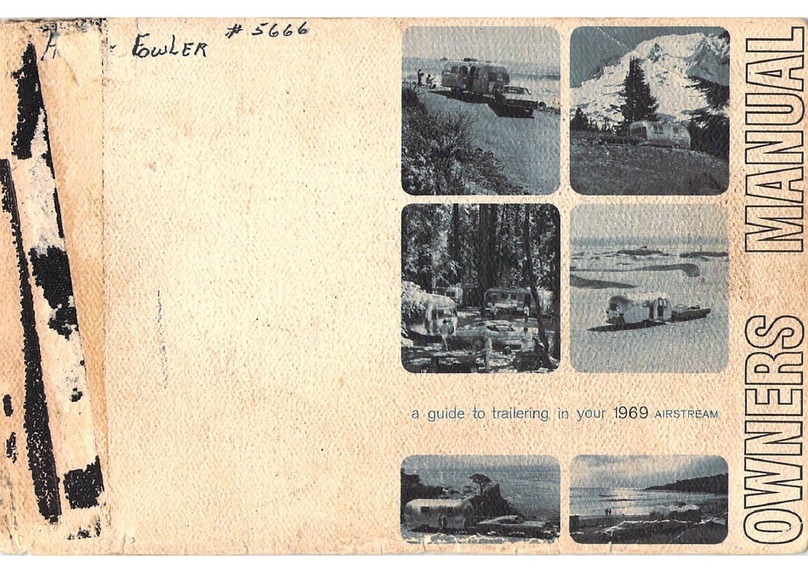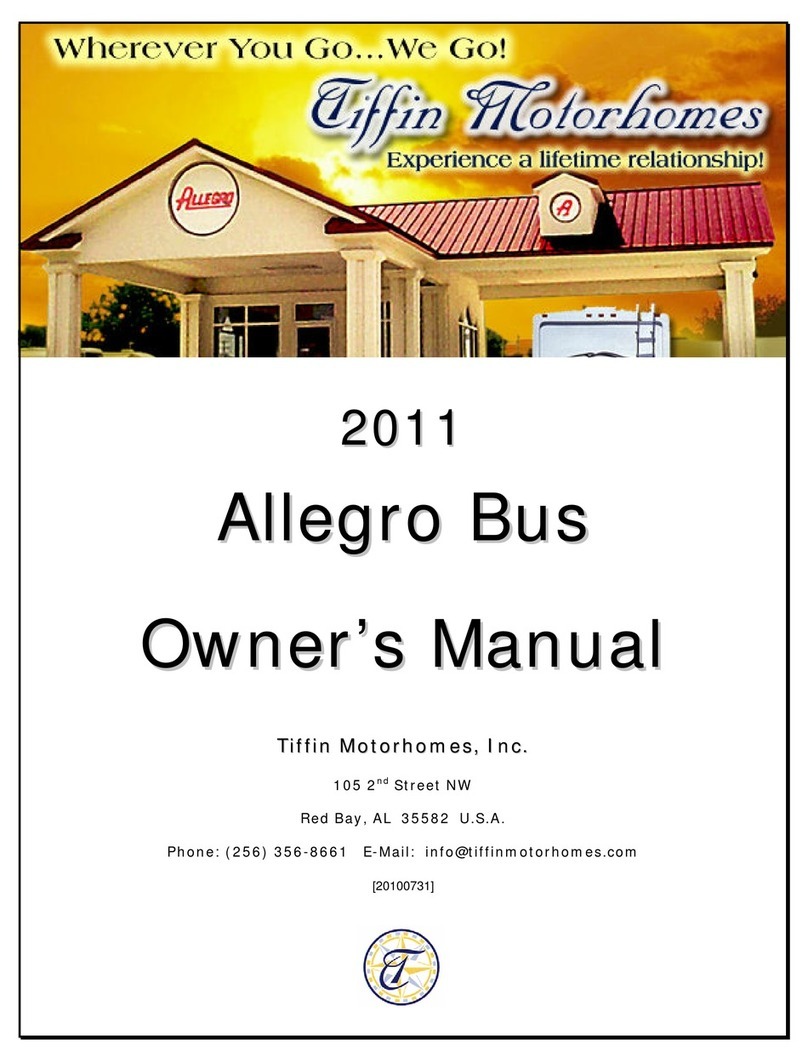Auto-Sleepers Gloucester2010 User manual

CONTENTS
Section
Introduction / Warranty / Trim & Materials ................................ 1
Motorhome Code ..................................................................... 2
Preparing for the Road ............................................................. 3
On the Road ............................................................................. 4
Arrival on Site ........................................................................... 5
Safety & Security...................................................................... 6
Connection of Services ............................................................ 7
Technical Specification ............................................................. 8
Fitted Equipment ...................................................................... 9
Care of your Motorhome ........................................................ 10
Useful Information ................................................................... 11
Service Section ...................................................................... 12
Index ...................................................................................... 13
Copyright © 2010 Auto-Sleepers Ltd. All rights reserved.
No part of this document may be reproduced or transmitted in any form or by any means, electronic
or mechanical, for any purpose, without the express written permission of Auto-Sleepers Ltd.
Front cover photograph by Michael Le Caplain.

DATA RECORD

1-1
Welcome.
Congratulations on your purchase of an Auto-
Sleeper motorhome. We are confident it will
give you many years of pleasure.
This handbook has been compiled to enable
you to obtain the maximum pleasure from
your vehicle. It contains the appliance
instructions along with advice on safety
matters.
Please read this Handbook thoroughly so that
you are conversant with all the motorhome
systems, operating instructions and
precautions.
Failure to observe these recommendations or
precautions may result in incorrect operation
of equipment and subsequent risk to
occupants.
Information leaflets and literature on safe
operation of appliances and equipment fitted
to your motorhome are included in the Auto-
Sleeper Customer Pack. Please read these
carefully prior to use.
Should you experience any difficulties contact
your dealer who will be pleased to offer
advise.
It is the policy of Mercedes and Auto-Sleeper
to improve continually their vehicles, so whilst
the details contained in this Handbook are
correct at the time of going to press, they
reserve the right to alter the specifications at
any time without notice.
Auto-Sleeper motorhomes offer a variety of
customer uses and whilst each vehicle
features the optimum storage, fluid, seating
and sleeping capabilities, it is the customer’s
responsibility to select the proper
combinations of loads without exceeding
weight capacities.
Your Auto-Sleeper motorhome conforms to
the European standard of EN 1646.
Model
This handbook covers the Mercedes
Gloucester, based on the Mercedes Sprinter
315 CDi long wheelbase chassis cab.
Gas System
This handbook is for use on vehicles with a
30mbar gas system. The gas system
pressure is noted on a label in the gas locker.
Conversion Type
Coach-built conversion, four or six berths.
Laminated panel and glass-fibre combination.
Insulated panels have GRP outer skin.
Climatic Conditions
The motorhome is designed for use in
temperate climates, and is certified Grade 1
in accordance with EN 1646-1: 2004,
indicating an effective heating system is fitted
but has not been tested for thermal
performance.
Handbook
Any queries should be addressed to your
Auto-Sleeper dealer.
Appliance Instructions
The appliance instructions included have
been extracted from those supplied from the
appliance manufacturers.
Automotive - Mercedes
For all automotive matters you should refer to
the Mercedes vehicle instructions manual.
This includes tyre pressures, referring to the
type of tyres fitted.
The Auto-Sleeper conversion does not affect
the tyre pressures in any way as it is built
within the design envelope of the base
vehicle.
IMPORTANT:
In the interests of safety, replacements parts
for appliances must conform to the
manufacturer’s specification and should be
fitted by them or an authorised agent..
Your Auto-Sleeper conforms to the CEN
Standard EN1646-1/2004 for habitation
requirements relating to Health and Safety.
INTRODUCTION

1-2
To deal with your queries efficiently, always
quote your vehicle’s production number
which can be found in the glove compartment
(eg N123).
Please read and complete the warranty
registration card supplied with your vehicle;
and return to the address below, without
delay.
Auto-Sleepers Limited,
Orchard Works,
Willersey,
Nr Broadway,
Worcestershire
WR12 7QF
Tele: 01386 853338
Fax: 01386 858343
E-mail: [email protected]
INTRODUCTION
This introduction is aimed at those who are
new to motor caravanning and indeed
caravanning in general. It is very much an
overview intended to match the expectations
of new owners with the facilities available in
their vehicle. Detailed technical advice is
available from many sources; dealers,
manufacturers and clubs such as the
Caravan Club.
Owners of motor caravans use their vehicles
differently. Some just as support for daytime
activities, some for occasional overnight stay
and others for longer stays sometimes on a
site with electricity and other facilities
available and sometimes at places with no
support facilities at all. There are many
variations in the design of motor caravans.
Some things like size and layout are obvious,
others such as optimising heating and
lighting for use with an external mains
service connection are not.
It is hoped that a new owner has considered
these matters and has procured a vehicle
that is suitable for the type of use they
intend, there will, however, still be a major
adapting process to be gone through. The
reason is that whilst the modern motor
caravan usually contains very similar
facilities to your home it is not usually
connected to main services. You will be
limited in your use of the facilities by the
capacity of the energy, fuel and water you
can carry and by the fact that there is a
limited capacity to carry waste fluids.
There follows a list of some of the facilities
and guidance on their use and on contraints
that apply:
Leisure battery
This battery (there may be more than one) is
provided in addition to the standard vehicle
battery to power facilities in the caravan
(habitation) area of the motor caravan. These
facilities can include lights, water pump, toilet
flush, heating blower and ignition for gas
appliances. The battery is charged by the
vehicle engine when it is running or by a built
in battery charger when the motor caravan is
connected to a mains electricity supply.
With a mains supply connected and the
charger switched on you can make unlimited
use of the battery supplied appliances and
the leisure battery will remain fully charged.
When not connected to the mains you could
switch all of the appliances on at once and
discharge the battery in a couple of hours. By
only switching on what you need when you
need it the battery can support you for three
or four days in the winter. A solar panel can
be installed as an extra that will give a small
charge to the battery and help it support you
for longer.
The output of the leisure battery and the
circuits it supplies are all protected by fuses.
You should find out where those fuses are
located and keep some spares to hand.
Unlike the vehicle battery the leisure battery
is not usually maintenance free. The
electrolyte in the battery will on occasion
need to be topped up with distilled water and
should be checked every month.
Gas
It is usual to have some devices (such as the
cooker) in the motor home fuelled by liquid
petroleum gas (LPG) and most vehicles are
designed to accept replaceable gas
cylinders.
LPG comes as either propane (red cylinder),
butane (blue cylinder) or occasionally as a

1-3
INTRODUCTION
blend of both. The gas is given off from a
liquid stored under pressure in the cylinders.
Butane is a more efficient gas but the liquid
stops producing gas below about 2ºC,
propane will produce gas in freezing
conditions and is suitable for use all year
round.
The pressure of the gas from the cylinders
varies as the cylinder empties. It is therefore
necessary to fit a pressure regulator
optimised for the gas used between the
cylinder and the appliances. On recently
manufactured motorhomes a universal
regulator is part of the vehicle’s standard gas
installation. Whether using independent
regulators or tail pipes to connect the
universal regulator to the cylinder it is
necessary to obtain items that are compatible
with the connection on the cylinder you have.
There are many different types of cylinder
connection in the UK and Europe.
Fresh water
There is a tank fitted to the motorhome to
hold a supply of fresh water for drinking,
cooking, washing, etc. It is essential that this
tank and the water in it is kept free from
contamination. Hose pipes are manufactured
(usually coloured blue) that are safe to use to
carry water used in food processes and only
this type of hose should be used to fill the
fresh water tank.
You will find many places where it is not
possible or convenient to use a hose. There
are many types of container/funnel
combinations which can be used to fill the
tank. You will find a combination that works
for you but whatever that is do not use it for
anything else in order to keep it free from
contamination.
If you carry your water to the motorhome you
will soon learn the disadvantages of leaving a
tap running, overfilling the kettle, etc. When
showering use the technique of having a
gentle spray to get wet, switch the tap off
while you soap/shampoo then a gentle spray
to rinse.
Grey water
Grey water is the name for the waste water
that comes through the vehicle plumbing to
the waste water tank and is not the foul liquid
accumulating in the toilet waste tank. Site
owners will give you guidance/instruction on
where to dispose of the contents of the waste
water tank.
Activities such as washing dishes can cause
particles of waste to be taken by the grey
water to the waste tank and over time they
can accumulate and cause smells. This effect
can be minimised by disposing of oil and
grease in foil containers and by washing up
in a bowl and taking the water direct to a grey
water disposal point.
The toilet
Toilets installed in motorhomes are not
connected to mains sewers. They have tanks
to collect the waste. A chemical is added to a
small amount of water in the empty tank, this
assists in reduction of solids and smells. A
special type of toilet paper should be used
that is designed to disperse rapidly in the
chemical.
Toilet tanks should only be emptied into foul
water sewers usually via the chemical toilet
(sometimes called Elsan) disposal point on a
campsite. They should never be emptied into
watercourses or surface water drains.
Always remember to check the bowl is empty
before removing the toilet tank. A full toilet
tank is heavy. It is a good idea to empty
regularly and to have a trolley available on
which to carry the tank on longer distances.
If the toilet has its own tank of flushing water
there are additives available that will assist in
cleaning and freshening the toilet bowl.

1-4
WARRANTY
Auto-Sleeper Warranty
1. Motorhomes produced by Auto-Sleepers Ltd
(hereafter referred to as the Company) are covered
by a 2-year warranty.
2. During this period the Company undertakes to repair
or, if deemed necessary by the Company, replace all
defective parts of the motorhome subject to the
conditions set out in this document.
3. This warranty commences on the day the vehicle is
registered with the relevant authorities in the original
country of sale OR 12 months from the date the
vehicle was invoiced to the supplying dealer
whichever is sooner.
4. The supplying Dealer must explain the warranty
terms and conditions to the purchaser and return the
completed Warranty Registration Card – see below -
to the Company to activate the warranty cover.
5. Auto-Sleepers Dealers are not agents of the
Company and cannot bind the Company to any
agreement for warranty work to be undertaken
unless they have obtained prior authority from the
Company.
6. Defects in the base vehicle are covered by the base
vehicle manufacturers warranty and any problems
with it, or its accessories, must be referred to the
base vehicle manufacturers’ agent.
7. Warranty cover is provided subject to the completion
of regular servicing/inspection by an authorised
Auto-Sleepers Dealer or NCC Approved Workshop
and this must meet the requirements of the NCC
Motorhome Habitation Service Schedule. These
services must take place on the anniversary - plus or
minus 60 days – of beginning of the warranty period.
The Owner should retain copies of the service
schedules and receipted invoices as proof that they
have been completed
8. All warranty issues must be reported, in the first
instance, to the supplying dealer.
9. Year One Cover
The warranty covers faults in the motorhome
conversion arising from manufacturing defects or
defective parts with the exception of.
a. Those exhibiting the effects of fair wear and
tear.
b. Damage and defects that have arisen as a
result of accident, misuse, negligence or
neglect.
c. Replacement bulbs, light emitting diodes,
fluorescent tubes, fuses.
d. Leisure batteries, unless covered for the
unexpired part of a 90 day warranty that begins
when the motorhome is delivered by the
Company to the Dealer.
10. Year Two Cover
The warranty covers is the same as year 1 with the
following additional exclusions.
a. External and interior door hinges and catches
b. Interior and exterior transfers, coach lines,
decals and adhesive décor parts
c. Interior and exterior surface finishes – including
all painted surfaces and heat shields
d. Glass worktops and mirrors
e. Soft furnishings, curtains, carpets, and other
floor coverings.
f. Window and roof light glazing units, blinds, fly
screens, stays and catches.
g. Microwaves, cookers, grills and hobs,
refrigerators, water heaters, space heaters,
TVs and audio equipment
11. General
These are terms applying to the whole warranty
period - the warranty does not cover,
a. The effects of normal wear and tear associated
with use, normal deterioration, corrosion, or
fading,
b. Accidental damage of any kind,
c. Damage caused by animals, rodents or others
pests,
d. Replacement parts where these have reached
the end of their effective working life,
e. Maintenance activities including; the
adjustment of doors and catches, servicing of
appliances or cleaning,
f. The supply of a replacement vehicle during any
repair period.
g. Costs incurred returning the Motorhome to a
repairer – these are the responsibility of the
owner.
h. Accommodation costs incurred as a result of a
failure of the vehicle, or any component in or on
it, or as a result of returning it to a place of
repair.
i. To make a claim under this warranty please
contact your supplying Auto-Sleeper Dealer.
12. Exclusions and Scope
a. Motorhomes hired or loaned for reward,
financial or in kind, are not covered by this
warranty.
b. Modifications, however minor, will invalidate the
warranty.
c. Cover is limited to motorhomes purchased and
used in the UK – cover for motorhomes used
outside the UK is limited to 90 days per
continuous trip.
d. If the motorhome is sold before the end of the
original warranty the benefit of the remaining
period can be transferred – see the Warranty
Transfer Form below- to the new owner using
the warranty transfer form. There is a fee for
this service of £100-00 + VAT.
Failure to request this transfer within 14 days
will invalidate the remaining warranty.
e. This warranty does not affect your rights as
protected by UK consumer legislation.

1-5
TRIM AND MATERIALS
Warranty Registration Card
The supplying Dealer must explain the warranty terms and conditions to you, the purchaser, and
return the completed Warranty Registration Card to the Company to activate the warranty cover.
Please sign below to say that you have had the warranty fully explained and that you understand
it and the servicing requirements therein. Signing does not affect your statutory rights.
Warranty Transfer Form
If the motorhome is sold before the end of the original warranty the benefit of the remaining
period can be transferred to the new owner using this form. A £100-00 + VAT fee is charged for
this service.
Failure to request this transfer within 14 days of purchase will invalidate the remaining warranty.
Registration Chassis Number
Number
Model Auto-Sleeper
Job Number
Purchaser
Address
Telephone E-mail
Supplying
Dealer
Customer
Signature
Dealer
Signature
Registration Chassis
Number Number
Model Auto-Sleeper
Job Number
New Owner
Address
Telephone E-mail
I have read and understand the terms and conditions of the warranty, including the servicing
requirements, as applicable to this vehicle.
Signed Date
........................................................................................................................................................
✂

1-6
BODY CONSTRUCTION:
Side Walls: GRP - Mercedes White.
Floor Vinyl: Dark Wood Block.
Furniture: Jakarta Teak.
Curtains: To match upholstery colour.
Carpet: OASIS Madrid.
Cushions/Upholstery: Standard - Gatsby.
Optional - Leya.
Exterior Graphics: BS1750/10.

2-1
MOTORHOME CODE
THE COUNTRY & COASTAL
CODES
Upon arrival at your destination you should
be aware of the Country Code relating to
motorhome owners. This is entitled the Motor
Caravanners’ Code.
Code of Conduct - Camp Sites
Arrivals
•Report to reception immediately on
arrival.
Vehicle Movement
•Keep to roadways unless otherwise
directed.
•Adhere to speed limits. Note that these
are generally 10 mph. (Remember that
the stopping distance on grass is
considerably greater than on tarmac).
•Only a person in possession of a current
driving licence may drive on the site.
•Park correctly as advised on your pitch.
Where possible leave 20ft of free space
around your vehicle.
Use of Site
•Use the electrical mains hook-up in the
correct manner and with caution.
•Ensure that all fresh water taps/
connections are turned off after use.
•Have care and consideration when using
all facilities (toilets and showers etc.) and
leave them clean and tidy. Young children
should be escorted.
To avoid possible damage to sewage
purification works, only approved chemical
fluids must be used. Under no circumstances
may coal tar, phenol or caustic-based fluids
be used. Disposable napkins and similar
bulky items must not be put into chemical
closet emptying points but should be
wrapped in a polythene bag and placed in the
container provided. (Put all litter in containers
marked for the purpose).
Noise
•Do not make excessive noise.
•Children should be restrained from
making excessive noise.
•Flying kites and model aircraft and the
use of items like catapults or air-guns as
well as ball games should not be
permitted among, or close to,
motorhomes.
•Musical instruments, record players,
radios and televisions should not be used
to the inconvenience of other people on
site.
•Open and close doors quietly.
•Power generators must be adequately
silenced and used with consideration and
according to restricted site times.
Dogs and Pets
•All dogs and other pets should be kept
under control.
•Unless permission has been granted, no
animal should be allowed loose on the
site and leads must not exceed 10ft.
•No animal should be allowed in the
shower/toilet blocks.
•Do not let dogs foul the site.
Fire Precautions
Adhere to and make note of all fire
precautions concerning the whereabouts of
the fire points.
Although not compulsory, it is recommended
that a 1 kg (2lb) dry powder fire extinguisher
is carried. It should comply with BS 5423 and
be marked BSI or FOC approved. It is
important to check at regular intervals that
the extinguisher is working as is required by
types meeting BS 5423.
Careful thought is necessary for the
positioning of the extinguisher, which should
be near the door but not too close to the
cooking equipment where sudden flames
could make it unreachable. In the kitchen
area, a fire blanket is a worthwhile
precaution.
Unless permission has been granted,
barbecues should not be used. When
permission has been given, consideration
should be given to the annoyance that can be
caused to other users of the site. Open fires
are not allowed.

2-2
MOTORHOME CODE
Awnings and Tents
Awnings and tents should only be used when
permission has been obtained.
When on grass and staying for more than a
few days, the ground sheet and/or side flaps
of awnings should be periodically raised in
order to avoid damage to the ground.
Departure
•Leave the pitch clean and tidy.
•On leaving, check out with the reception
paying the required dues.
Wild camping
Camping away from licensed sites, without
the permission of the landowner or his agent,
is not allowed in the United Kingdom. When
permission has been granted, all aspects of
this Code should be adhered to.
On no accounts should:
•Litter be disposed of other than in
receptacles provided.
•Water be allowed to escape from the
vehicle.
•Chemical toilets be emptied except into
the disposal places agreed with the
landowner.
•Washing or similar be hung outside the
vehicle.
Parking
Motorhomes should only be parked in
approved places.
When using the facilities of a motorhome at
such times, care and consideration should be
given to those around them.
Driving
When using a motorhome on either the public
highway or private road, the Highway Code
should be complied with and full
consideration given to other road users.
In the event of a motorhome travelling slowly
and there being a queue of traffic behind, the
driver of the motorhome should, where
possible, pull over in order to let the other
traffic pass.
When the vehicle is in motion it is compulsory
that all passengers are seated and seat
restraint straps worn.
Exterior steps should be properly retracted
and secured.
When the vehicle is being refuelled, or on a
ferry, all gas systems must be turned off.
Gas appliances should only be used when
the vehicle is in motion when the
manufacturer of the appliance permits such
use.
Handbook
Before using a motorhome all aspects of the
handbooks produced by the chassis
manufacturer and the converter must be read
and adhered to.
Environment
Care and consideration should be taken to
protect the environment.
Observe the Country and Coastal Codes
shown below:
The Country Code
Enjoy the countryside but respect its life and
work.
More people than ever before are exploring
the countryside, interested in farming, plant
life, bird watching or just observing the
general wildlife. Whatever your interest, there
is a lot to learn, but please observe the
following code.
Guard against all risk of fires. Hay and heath
land catch alight easily and once ablaze are
very hard to put out. Remember: Fire
Spreads Quickly.
•Keep to public paths across farmland.
•Use gates and stiles to cross fences,
hedges and walls.
•Leave livestock, crops and machinery
alone. View from a distance.
•Take your litter home - it is unsightly and
harmful to wildlife.
•Help to keep all water clean.
•Take special care of country roads.
•Make no unnecessary noise. Most
animals are very timid, noises can disturb
them unnecessarily. If you want to get the
best out of the country, go quietly.

2-3
MOTORHOME CODE
The Coastal Code
As our coastlines are increasingly used for
recreation and education, the following
suggestions are made to enable us to enjoy
our inheritance and preserve it for posterity.
•Do not trample about, or move rocks
unnecessarily.
•Do not frighten seals or seabirds.
•Do not spear fish.
•Do not spill detergents, solvents or fuel
from boats as these can kill marine life.
•When sailing, moderate your speed - the
wash from a fast boat can destroy banks
and nests.
•Live mollusks and crustaceans need not
be collected as souvenirs - dead shells
can usually be found.
•Shellfish can take years to grow and
fines can be imposed for not observing
national regulations.
•Do not pull up seaweed unnecessarily.
•Make your visit instructive - not
destructive.
•Look at material, don’t remove it. Take
notes and photographs, not specimens.
•Observe bye-laws and be considerate to
others.
•National Trust property or Country Parks
have regulations to protect the wildlife.
Follow these.
Fire Precautions
You should also make yourself aware of the
local fire regulations.

2-4
MOTORHOME CODE

3-1
PREPARING FOR THE ROAD
YOUR MOTORHOME (Weights
explained)
Mass in Running Order (MRO)
The weight of your motorhome as it leaves
the factory, as new with standard fixtures and
fittings, plus an allowance for driver and 90%
fuel.
Maximum Technically Permissible Laden
Mass (MTPLM)
The maximum weight of the vehicle when
fully laden for use on the road. See
specification section for actual figure.
User Payload
The load margin (payload), this represents
the difference between the Mass in Running
Order (MRO) and the Maximum Technically
Permissible Laden Mass (MTPLM). It shows
the maximum weight which can be loaded
into your motorhome, covering items such as
food, crockery, cutlery, clothing, bedding, gas
cylinders, etc. See Technical Specification for
actual figure.
Please take care to ensure that you have
allowed for the masses of all items you intend
to carry in the motorhome, e.g.. passengers,
optional equipment, essential habitation
equipment and personal effects such as
clothing, food, pets, bicycles etc.
Although there are additional seat belts within
the motorhome, please refer to the stated
number of passengers that are allowed due
to the MRO and MTPLM.
LOADING AND DISTRIBUTION OF
WEIGHT IN THE MOTORHOME
Loading
Correct weight distribution is a major factor in
making your motorhome a balanced and
pleasant vehicle to drive without
compromising road-holding. Care should
therefore be taken to ensure that heavy items
are well spaced and are in as low a position
as possible, for example, low cupboards and
bed boxes.
DO NOT EXCEED THE STATED MAXIMUM
LOAD. ITEMS FITTED OTHER THAN
STANDARD EQUIPMENT WILL DEPLETE
THE PAYLOAD STATED IN THIS
HANDBOOK.
WARNING: Under no circumstances
should the maximum permissible laden
mass of the motorhome be exceeded.
Roof Loading
DO NOT ALLOW CHILDREN TO CLIMB
ONTO THE ROOF.
Roof Rack Bars and Ladder (optional)
When using the optional roof rack, care
should be taken to see that all the items are
securely anchored. Apart from general
cleaning and polishing, the roof rack and
ladder require no special maintenance.
WARNING: Take special care when on the
roof in wet or frosty weather conditions,
which cause it to be particularly slippery.
Maximum load within the area encompassed
SENSIBLE LOADING
HOW TO APPORTION WEIGHT

3-2
PREPARING FOR THE ROAD
by the roof rack should not exceed 75 kgs
(165 lbs) with a maximum loading of 8 kg (17
lbs) per square foot.
Before Moving Off
Whenever making a journey with your
motorhome, either setting off on holiday or
returning home, it is good practice to run
through this simple checklist.
1. Close and secure all cupboards and
drawers and check any loose articles. Do
not store tins, bottles, etc. in overhead
lockers.
2. Close and secure all windows and roof
lights.
3. Leave all curtains and blinds open to aid
visibility.
4. Check that gas cylinders are securely
fastened and turn off all gas appliances,
except those heating appliances
designed to function while the vehicle is
in motion. Also, ensure that the gas
locker door is securely fastened.
5. Ensure that there is sufficient gas to meet
your needs.
6. Switch off 230 volt supply at source,
disconnect mains cable from site supply
before disconnecting from vehicle.
Beware of potential electric shock from
wet cable. Coil cable and store in a safe
place.
7. Check your RCD’s/MCB’s for operation.
8. Check and if necessary, charge the
conversion battery.
9. Check battery selection switch is in the
OFF position.
10. Check that the battery is secure and that
the battery box lid is fastened.
11. Ensure the fridge is on 12V operation
and door lock is set. (Note: the electrical
relays will allow the fridge to be run on
the vehicle battery when the engine is
running.)
12. Remove any external fresh water
connections etc.
13. Make sure any heavy articles are stored
in accordance with the loading
procedure. Tables should also be made
secure.
14. Lock the motorhome exterior door
(remember to take out your keys).
15. Check your external rear view mirrors
and adjust if necessary.
16. Check that all corner steadies are wound
up and that, if a step is used, it is put
away before moving off.
17. Check wheel nuts are secure and tyre
pressures are correct.
18. Ensure, if required, that your fresh water
tank is full and your waste tank is empty.
19. Referring to your base vehicle manual,
check all fluid levels including automotive
fuel and tyre pressures. Remember to
check that your spare tyre is of the
recommended pressure.
20. Ensure that, on models fitted with an
elevating roof, the roof is securely locked
down with the exterior catches applied.
21. The fridge vent covers should be fitted
when the vehicle is to be driven in order
to comply with European Type Approval
regulations for vehicle external
projections.
22. Ensure that the toilet flush tank only
contains a small amount of water (1-2
litres) in order to minimise the risk of
leaks or spillage whilst the vehicle is in
motion.
23. Check underneath the vehicle for stray
items.
24. Safely store levelling blocks away in an
appropriate place.

4-1
ON THE ROAD
Pulling Off
Engage the clutch smoothly.
Avoid wear and tear on clutch and
transmission by taking extra care.
Change gears smoothly.
Try not to jerk the clutch.
MOTORWAY DRIVING
Speed Limits (UK)
If a speed limit is not in force, your
motorhome can be driven up to 70mph on
motorways, 60 mph on dual carriageways
and 50 mph on single carriageways.
1. Reduce Speed:
i) In high or cross winds.
ii) Downhill.
iii) In poor visibility.
2. High sided vehicles cause air buffeting,
so extra care must be taken when
passing or being passed. As much space
as possible should be given.
Motorway Handling
Do not bump the kerb with the wheels.
When passing other vehicles allow more than
the normal clearance.
Allow longer to get up speed to pass.
Do not swing out suddenly.
Carry out all manoeuvres as smoothly as
possible.
Use nearside wing mirror to check
motorhome has cleared when overtaking.
Spare Wheel
CAUTION: Familiarize yourself with this
section prior to driving the vehicle and
take careful note of the warnings given.
Your Mercedes vehicle does not have a
spare wheel. Instead it is supplied with a tyre
sealant system to seal small punctures,
particularly those in the tyre tread. The tyre
sealant system is located in the stowage
compartment in the right hand door sill.
For full instructions on how to use the tyre
sealant, refer to the Mercedes handbook
supplied with the vehicle. Look in the index at
the front of the book for the section entitled
‘Tyre sealant’ which gives details of the
storage location and using the sealant.
After using the sealant, drive to the nearest
workshop, at a maximum speed of 50 mph,
to have the tyre repaired or replaced.
Rear Step
On moving off the rear step retracts
automatically. In the event of the rear step
being left extended, a buzzer, positioned
behind the dashboard, will sound (when the
ignition is switched on) - and will continue to
do so until the rear step has been fully
retracted.
Marker Lights
Marker lights are fitted to the front, rear and
side (if required) of the vehicle. These
illuminate when the side and/or headlights
are switched on. They use a 12V cap-less
push-in type bulb which is accessed by
removing the lens which is held in place by
two screws.
Cycle Rack
In order that a cycle rack can be fitted, the
rear panel coachwork has been strengthened
accordingly. Timber is bonded into the
bodywork immediately above the rear light
units, laterally across the vehicle. This allows
the lower mounting brackets for the Fiamma
Pro-C cycle rack to be fitted in a suitably
reinforced area. In the event of a cycle rack
being fitted, the cycle rack when folded will
increase the vehicle length by 400mm. Your
Auto-Sleeper dealer will give further advice or
assistance if required.
Whilst Driving
Whilst the vehicle is being driven ensure that:
•Both the passenger and driver wear seat
belts - this is a legal requirement.
•Heavy loads are not stored in top
cupboards or in areas from which they
may become detached. Please ensure
that heavy items are stored low down
and take care not to overload individual
wheels, the axles or the MTPLM.
•Table(s) are stowed in the correct
position and table legs secured in their
retaining clips.

4-2
ON THE ROAD
•Furniture lids are lowered; cupboards
and flaps are closed and secured.
•The refrigerator door is closed and
secured by its travelling catch.
•The retractable rear step if fitted, is
folded away or, if a separate step is
supplied, it is safely stowed in the
vehicle.
•Roof ventilators are closed and locked in
the down position.
•The bathroom is not used whilst the
vehicle is in motion. (Note: Refers only to
models fitted with shower or toilet
compartment).
•Top hinged windows are closed, and
securely fastened.
•Children do not roam around the vehicle;
they may fall and injure themselves.
Front Seat Swivel (where fitted)
Your vehicle may be fitted with a swivel base
to either or both of the front seats, so that
they may be turned to face the rear of the
vehicle. The release handle, coloured red, is
located on the inside of the seat and is
moved rearwards to unlock the swivel
mechanism.
WARNING: It is important that while the
vehicle is in motion, any seat swivels are
locked in the forward facing position.
Map Storage
In the rear of each cab seat there is a map
pocket for storage of maps, periodicals and
light items.

5-1
ARRIVAL AT SITE
CHECK SITE REGULATIONS
Siting your Motorhome
When siting your motorhome, keep to the
roadways unless otherwise directed. Obey
the speed limit which, in general, is 10 mph.
Only a person in possession of a current
driving licence is permitted to drive on the
site. Stopping distances on grass are
considerably greater than on tarmac.
Selecting a Pitch
Carefully select where you wish to park your
motorhome. The site should be as level as
possible, well drained and away from boggy
areas and, preferably, not under or near
trees. Consider also, how you will move your
motorhome when leaving the site. For
example, on sloping ground in wet
conditions, pitch facing downhill.
Levelling
The optional rear corner steadies, which can
be lowered by using the brace supplied, are
designed to give greater stability to the
vehicle when it is stationary on site. The
brace is stored in the wardrobe.
Note: On no account should the rear corner
steadies be used to jack up the vehicle when
carrying out maintenance or changing a
wheel.
It is important to site your motorhome level to
ensure correct operation of the refrigeration,
cooker, etc, by using purpose made ramps
and NOT bricks or such items.
Awning Light
The exterior awning light is controlled by the
‘Aux’ switch on the electrical control panel.
Fridge Vent Covers
Remove the fridge ventilation covers from the
outside vents, by turning the screws anti-
clockwise and pulling the covers gently
outwards from the bottom. Store in a safe
place and replace in the reverse fashion,
prior to driving on public roads as noted in
section 3.

5-2
ARRIVAL AT SITE

6-1
SAFETY & SECURITY
SAFETY
Important: Your attention is drawn to the
notice affixed in the motorhome advising on
fire prevention, ventilation and what to do in
case of fire.
Children
Do not leave children alone in the motorhome
in any event, keep potentially dangerous
items out of reach as at home. e.g. matches,
drugs, etc.
WARNING: When upper bunks are used
by children especially under six years of
age care shall be taken against the risk of
them falling out.
Fire Extinguishers
It is recommended that a 1 kg (2lb) minimum
capacity dry powder fire extinguisher be
located by the main exit door at all times.
A fat pan fire should not have an extinguisher
aimed at it but be smothered with a fire
blanket (which should be stored by the
cooker).
In case of fire
1. Get everyone out of the motorhome as
quickly as possible using whichever exit
is the quickest including windows. Do not
stop to collect any personal items.
2. Raise the alarm — Call the fire brigade.
3. Turn off gas container valve if safe to do
so.
Ventilation and Condensation
The ventilation points on your motorhome are
fixed points of ventilation which are stated by
the European Standards. Under no
circumstances must these vents be blocked
or obstructed. It is advised that fixed
ventilation points and any protective screens
are checked and cleaned (if necessary) on a
regular basis.
Fresh air circulation should be allowed below
the motorhome when appliances are in use
and when flues terminate below the floor to
allow free evacuation of the products of
combustion. At least three sides of the
underfloor space should always be kept open
and unobstructed especially by snow. Do not
make any additional openings in the floor.
Under no circumstances must these vents
be blocked or obstructed.
Additional night time ventilation is obtained
by releasing the window catches and placing
them in the second groove on the frame
catch.
Awnings
There is no danger of pollution of an
enclosed awning space by the LPG exhaust
from the refrigerator venting into it.
WARNING: Space heaters may produce
sufficient exhaust gases to pollute the
awning space if it is totally enclosed (from
a general comfort, smell, and hygiene
point of view). In the extreme case, there
could be a build up of carbon dioxide to a
dangerous level.
Note: Motorhome owners are advised to
allow some fresh air circulation into the
awning space when such appliances are in
use. It should be noted that the space heater
flue terminates on the offside of the vehicle.

6-2
SAFETY & SECURITY
ELECTRICAL SYSTEMS
Batteries
Battery terminals and connectors should be
firmly attached. Battery surfaces should be
free of moisture and dirt.
Where removable cell taps are fitted these
must be screwed firmly home.
When removing a battery always remove the
negative cable first. On re-connection the
negative cable should be connected last.
Switch off all lamps and appliances before
disconnecting the battery. Do not smoke
while working on or near to the battery.
Fuses
Always replace blown fuses with one of a
correct rating.
Overload
Never overload any electrical circuit,
especially the 12-volt socket outlet. The
rating of appliances should be checked
before connection.
Shower Compartment Light
Ensure that water does not ingress into the
light unit.
Charger Unit
Keep the charger unit well ventilated and
never allow material or bags to be in contact
with the unit casing which gets hot when the
unit is operating.
230 Volt Mains Operation
Before connecting to the supply, ensure that
the contacts in both the plug and the socket
are clean and dry and that the hook-up plug
is firmly located and locked into the socket.
The RCD must be easily accessible at all
times.
GENERAL
Before using your Auto-Sleeper, you should
be fully conversant with the following safety
precautions; if you are in any doubt as to the
meaning of any of them you should contact
your supplying Auto-Sleeper dealer. Please
read the following carefully.
In the interests of safety, replacement parts
for appliances should conform to the
appliance manufacturer’s specification and
should be fitted by them or their authorised
agent.
WARNINGS:
1Never use portable cooking or heating
equipment, other than electric heaters
that are not of the direct radiant type,
as it is a fire and asphyxiation hazard.
2Do not use cookers as heaters or dry
clothes etc on the cooker or space
heater.
3Make sure that combustible materials
can not come into contact with hot
surfaces or burners.
4Surfaces of appliances may become
hot in use and the guard provided
does not give full protection to the
young and elderly.
5Do not use additional independent gas
appliances inside the vehicle.
6Never allow modifications of electrical
or LPG systems or appliances except
by qualified technicians.
The water heater fitted to this vehicle is of the
“room sealed” type, any replacement should
be the same, i.e. “room sealed”.
Turn off all gas equipment and cylinders/
tanks and any other heating appliances
before travelling.
Ventilation openings are located below all the
gas appliances, and in the base of the gas
locker. In winter conditions make sure the
vents are clear of snow and mud. These
openings should be regularly checked and
any mesh covering them cleaned with a stiff
brush to prevent any risk of them becoming
blocked. The openings are provided for your
safety - please do not obstruct them.
Air Bags
Do not fit rear-facing children’s seats to front
facing seat protected by air bags. It is
recommended that small children do not sit in
the front passenger seat whilst the vehicle is
in motion. Follow the advice given in your
base vehicle instruction book.
Table of contents
Other Auto-Sleepers Motorhome manuals

Auto-Sleepers
Auto-Sleepers Topaz User manual

Auto-Sleepers
Auto-Sleepers 2003 Volkswagen Topaz User manual

Auto-Sleepers
Auto-Sleepers Peugeot Kemerton User manual

Auto-Sleepers
Auto-Sleepers 1991 Trident User manual
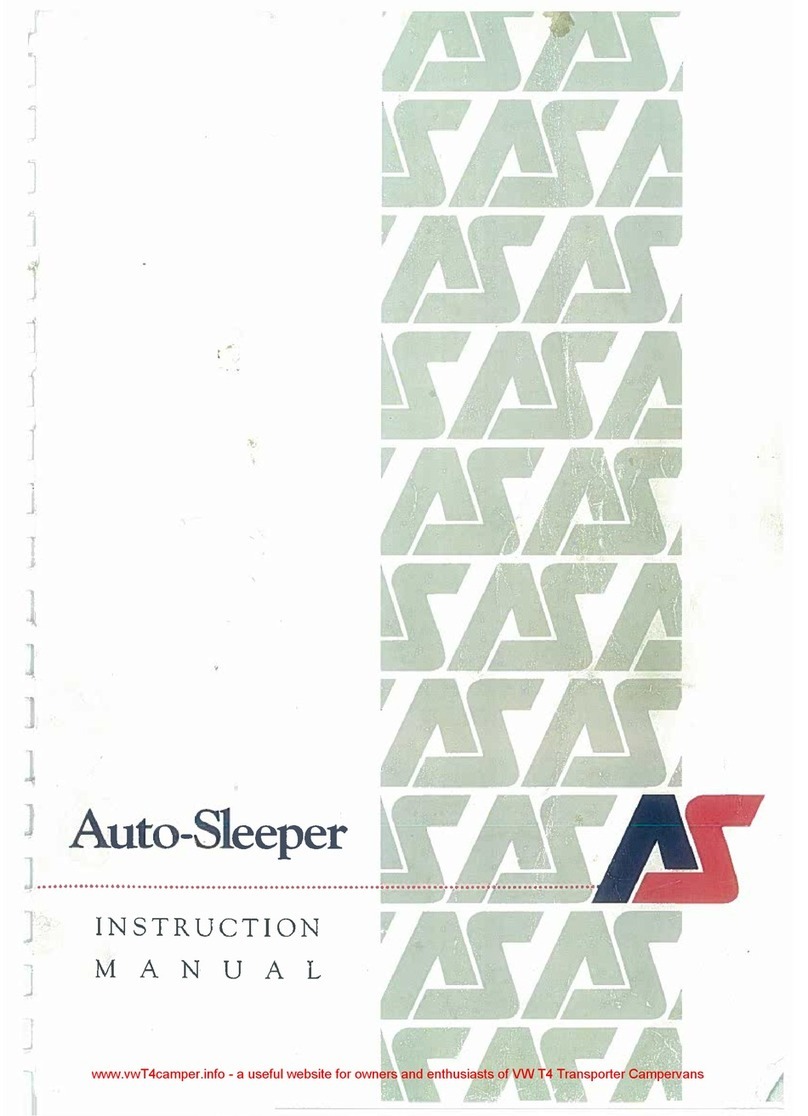
Auto-Sleepers
Auto-Sleepers Talent User manual
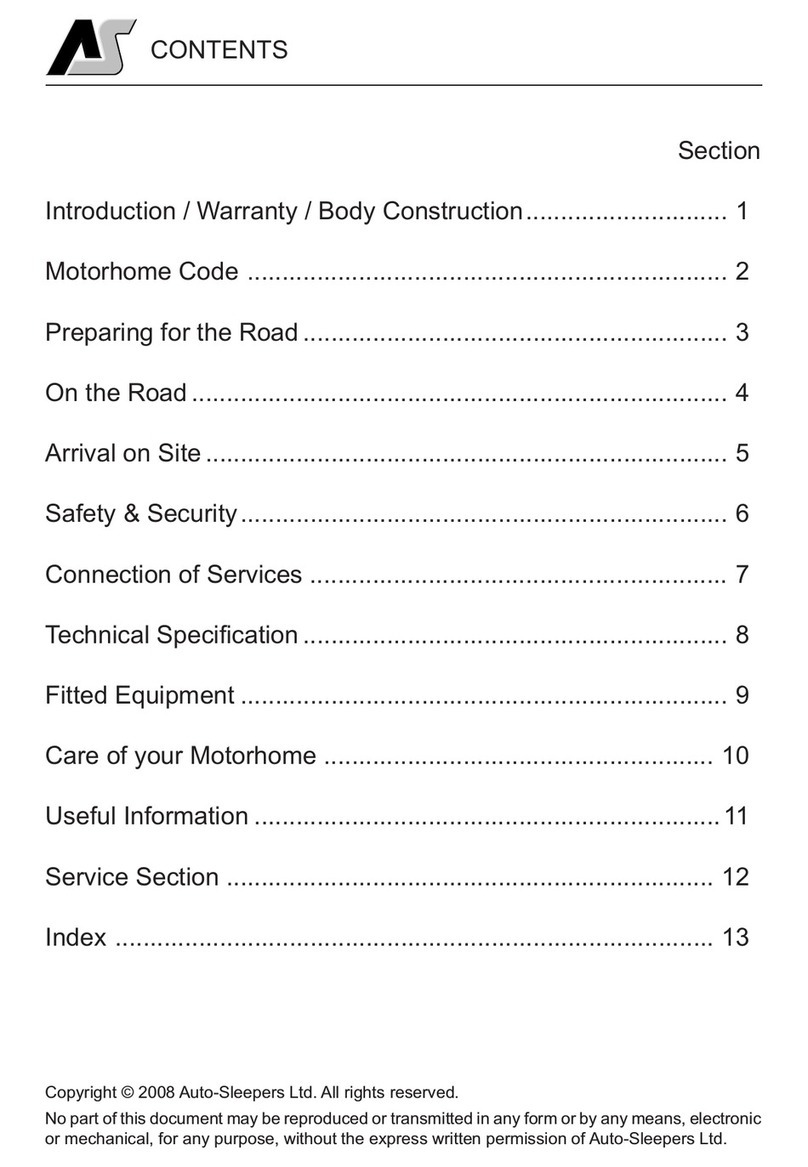
Auto-Sleepers
Auto-Sleepers warwick duo 2008 User manual

Auto-Sleepers
Auto-Sleepers FORD TRANSIT CUSTOM AIR 2022 User manual
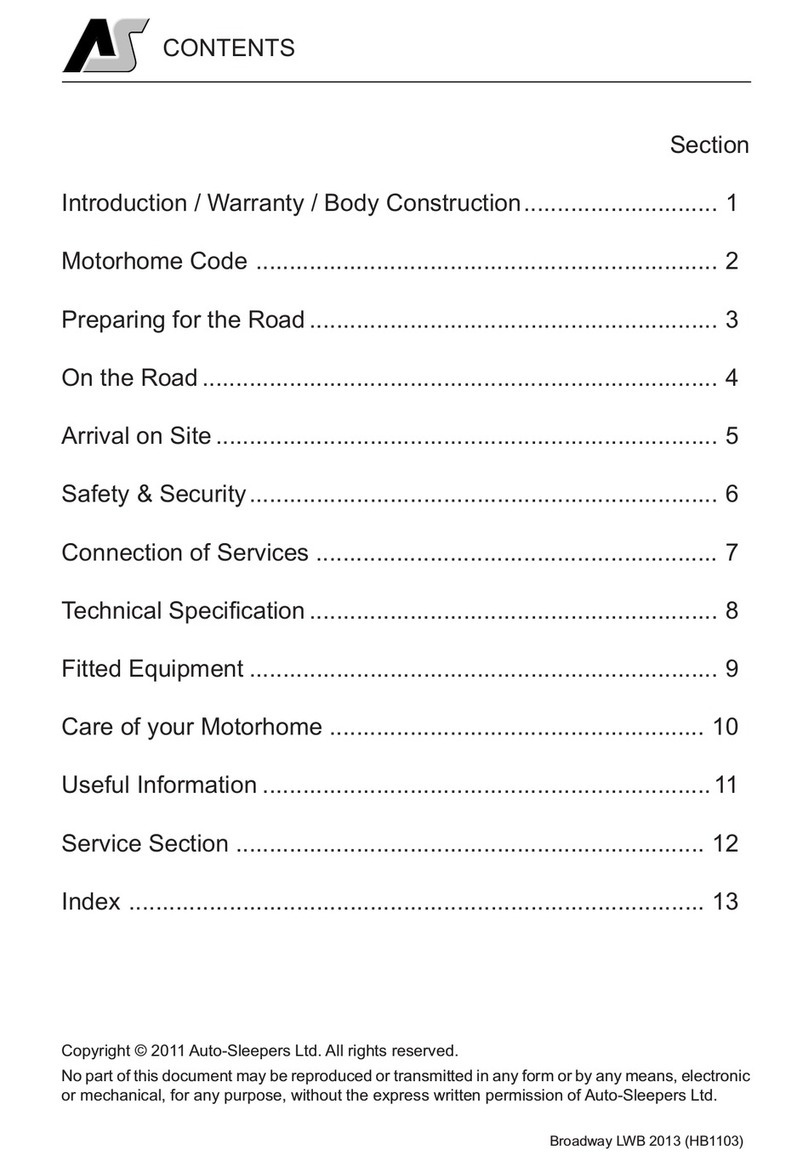
Auto-Sleepers
Auto-Sleepers Broadway FB User manual

Auto-Sleepers
Auto-Sleepers Trophy User manual
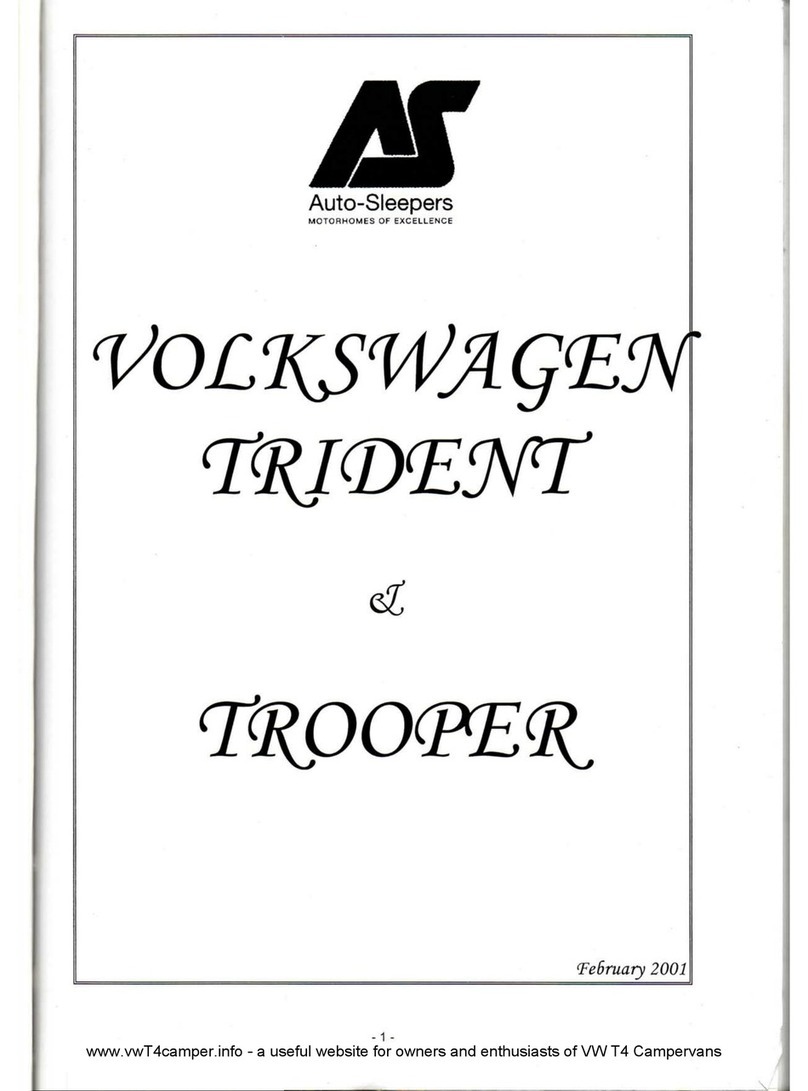
Auto-Sleepers
Auto-Sleepers 2001 Trident User manual

